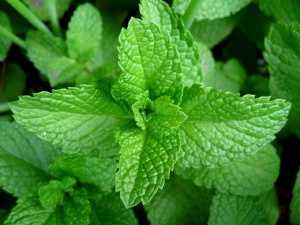Peppermint
Contents
Description & Origin
Peppermint is a perennial herb which belongs to the plant family Labiatae. It can be found growing freely in damp places throughout Europe and the United States. The plant usually grows in heights of 2-4 feet, with short leaves, purplish colored stalks and whorled clusters of reddish-violet flowers. Its odor is strong, with a taste experience of initially hot to cool on the tongue. Other names commonly used for this herb are brandy mint, balm mint, curled mint and lamb mint.
Constituents & Actions
Contained in the peppermint plant's leaves, stems and oils are azuline, cineol, isovalerate, menthol, menthone, menthyl acetate, bitters and tannin.
Peppermint acts as a mild alterative (cleanser, aids in removal of waste products), analgesic (relieves pain), anodyne (reduces pain), anti-bacterial, anti-microbial, anti-nauseate, antiseptic, anti-spasmodic (prevents or relieves spasms), anti-viral, aromatic (contains volatile, essential oils which aid digestion, relieves gas), astringent and calmative.
Actions also include carminative (relieves intestinal gas pain and distension), digestive, nervine (strenghtens nervous system, may be stimulants or sedative), sedative, stimulant (gastric), stomachic and tonic.
Medicinal Uses
Peppermint is well-known as one of the oldest household remedies, and has been used historically in every known society. It was used for the colds, fever control, bowel eliminations and tonification by the American Indian.
Most specifically, peppermint is used in problems related to digestion, colon and bowel. As a gastric stimulant, it helps stimulate the flow of stomach digestive fluid while strenghtening and toning the stomach. This herb can be used in enemas for colon issues. It's especially helpful for those suffering with irritable bowel syndrome.
Peppermint has an oxygenating effect in the bloodstream, therefore becomes an excellent energizer and blood cleanser. This action also helps to improve respiratory functions. Pregnant women may use this herb after the first trimester, to help digestion and overcome nausea, but doctor notification is always advised before using any herbs. Some conditions that may improve with the use of peppermint are as follows:
- Appetite (controls)
- Bronchitis
- Chills
- Colds
- Colic
- Colitis
- Constipation
- Convulsions
- Cramps (stomach)
- Diarrhea
- Digestion (aids)
- Fevers
- Flu
- Gas (flatulence)
- Headache
- Heartburn
- Insomnia
- Nausea
- Nerves
- Shock
- Toothaches
Culinary & Other Uses
Peppermint has a uniquely strong flavor that is sweet, tangy and initially hot with a cool aftertaste. It's commonly used in teas, liquors, salad dressings, marinades and adds a decorative touch to both entrees and desserts. It is often used to flavor chewing gum, toothpaste and mouthwashes.
Peppermint's lively and refreshing scent is also popular in shampoos and deodorants. It is used frequently as a household cleaner and deodorizer.
Side Effects & Interactions
Peppermint may antidote homeopathic remedies. It may lower both blood pressure and blood sugar, so those taking related medications should first consult with their physician. This herb may worsen symptoms of acid reflux or GERD, and gallstones. It should be taken at least 2 hours before or after antacids.
Topical application can cause rashes on sensitive skin. Large doses of peppermint are discouraged and can be toxic.
